Hyeontaek Lim
Gemini 1.5: Unlocking multimodal understanding across millions of tokens of context
Mar 08, 2024Abstract:In this report, we present the latest model of the Gemini family, Gemini 1.5 Pro, a highly compute-efficient multimodal mixture-of-experts model capable of recalling and reasoning over fine-grained information from millions of tokens of context, including multiple long documents and hours of video and audio. Gemini 1.5 Pro achieves near-perfect recall on long-context retrieval tasks across modalities, improves the state-of-the-art in long-document QA, long-video QA and long-context ASR, and matches or surpasses Gemini 1.0 Ultra's state-of-the-art performance across a broad set of benchmarks. Studying the limits of Gemini 1.5 Pro's long-context ability, we find continued improvement in next-token prediction and near-perfect retrieval (>99%) up to at least 10M tokens, a generational leap over existing models such as Claude 2.1 (200k) and GPT-4 Turbo (128k). Finally, we highlight surprising new capabilities of large language models at the frontier; when given a grammar manual for Kalamang, a language with fewer than 200 speakers worldwide, the model learns to translate English to Kalamang at a similar level to a person who learned from the same content.
Gemini: A Family of Highly Capable Multimodal Models
Dec 19, 2023Abstract:This report introduces a new family of multimodal models, Gemini, that exhibit remarkable capabilities across image, audio, video, and text understanding. The Gemini family consists of Ultra, Pro, and Nano sizes, suitable for applications ranging from complex reasoning tasks to on-device memory-constrained use-cases. Evaluation on a broad range of benchmarks shows that our most-capable Gemini Ultra model advances the state of the art in 30 of 32 of these benchmarks - notably being the first model to achieve human-expert performance on the well-studied exam benchmark MMLU, and improving the state of the art in every one of the 20 multimodal benchmarks we examined. We believe that the new capabilities of Gemini models in cross-modal reasoning and language understanding will enable a wide variety of use cases and we discuss our approach toward deploying them responsibly to users.
PaLM 2 Technical Report
May 17, 2023



Abstract:We introduce PaLM 2, a new state-of-the-art language model that has better multilingual and reasoning capabilities and is more compute-efficient than its predecessor PaLM. PaLM 2 is a Transformer-based model trained using a mixture of objectives. Through extensive evaluations on English and multilingual language, and reasoning tasks, we demonstrate that PaLM 2 has significantly improved quality on downstream tasks across different model sizes, while simultaneously exhibiting faster and more efficient inference compared to PaLM. This improved efficiency enables broader deployment while also allowing the model to respond faster, for a more natural pace of interaction. PaLM 2 demonstrates robust reasoning capabilities exemplified by large improvements over PaLM on BIG-Bench and other reasoning tasks. PaLM 2 exhibits stable performance on a suite of responsible AI evaluations, and enables inference-time control over toxicity without additional overhead or impact on other capabilities. Overall, PaLM 2 achieves state-of-the-art performance across a diverse set of tasks and capabilities. When discussing the PaLM 2 family, it is important to distinguish between pre-trained models (of various sizes), fine-tuned variants of these models, and the user-facing products that use these models. In particular, user-facing products typically include additional pre- and post-processing steps. Additionally, the underlying models may evolve over time. Therefore, one should not expect the performance of user-facing products to exactly match the results reported in this report.
PaLM: Scaling Language Modeling with Pathways
Apr 19, 2022



Abstract:Large language models have been shown to achieve remarkable performance across a variety of natural language tasks using few-shot learning, which drastically reduces the number of task-specific training examples needed to adapt the model to a particular application. To further our understanding of the impact of scale on few-shot learning, we trained a 540-billion parameter, densely activated, Transformer language model, which we call Pathways Language Model PaLM. We trained PaLM on 6144 TPU v4 chips using Pathways, a new ML system which enables highly efficient training across multiple TPU Pods. We demonstrate continued benefits of scaling by achieving state-of-the-art few-shot learning results on hundreds of language understanding and generation benchmarks. On a number of these tasks, PaLM 540B achieves breakthrough performance, outperforming the finetuned state-of-the-art on a suite of multi-step reasoning tasks, and outperforming average human performance on the recently released BIG-bench benchmark. A significant number of BIG-bench tasks showed discontinuous improvements from model scale, meaning that performance steeply increased as we scaled to our largest model. PaLM also has strong capabilities in multilingual tasks and source code generation, which we demonstrate on a wide array of benchmarks. We additionally provide a comprehensive analysis on bias and toxicity, and study the extent of training data memorization with respect to model scale. Finally, we discuss the ethical considerations related to large language models and discuss potential mitigation strategies.
Pathways: Asynchronous Distributed Dataflow for ML
Mar 23, 2022

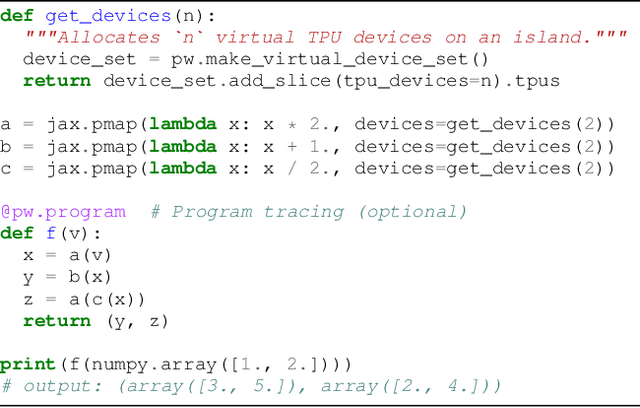

Abstract:We present the design of a new large scale orchestration layer for accelerators. Our system, Pathways, is explicitly designed to enable exploration of new systems and ML research ideas, while retaining state of the art performance for current models. Pathways uses a sharded dataflow graph of asynchronous operators that consume and produce futures, and efficiently gang-schedules heterogeneous parallel computations on thousands of accelerators while coordinating data transfers over their dedicated interconnects. Pathways makes use of a novel asynchronous distributed dataflow design that lets the control plane execute in parallel despite dependencies in the data plane. This design, with careful engineering, allows Pathways to adopt a single-controller model that makes it easier to express complex new parallelism patterns. We demonstrate that Pathways can achieve performance parity (~100% accelerator utilization) with state-of-the-art systems when running SPMD computations over 2048 TPUs, while also delivering throughput comparable to the SPMD case for Transformer models that are pipelined across 16 stages, or sharded across two islands of accelerators connected over a data center network.
Sequential Routing Framework: Fully Capsule Network-based Speech Recognition
Jul 23, 2020
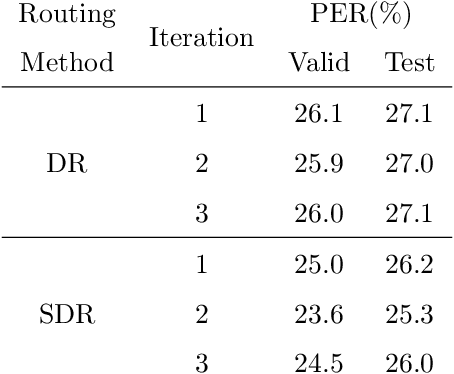

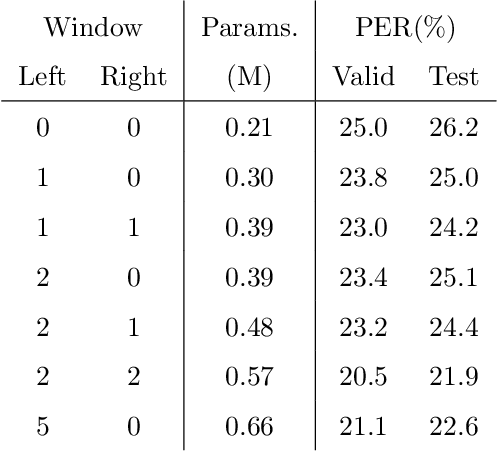
Abstract:Capsule networks (CapsNets) have recently gotten attention as alternatives for convolutional neural networks (CNNs) with their greater hierarchical representation capabilities. In this paper, we introduce the sequential routing framework (SRF) which we believe is the first method to adapt a CapsNet-only structure to sequence-to-sequence recognition. In SRF, input sequences are capsulized then sliced by the window size. Each sliced window is classified to a label at the corresponding time through iterative routing mechanisms. Afterwards, training losses are computed using connectionist temporal classification (CTC). During routing, two kinds of information, learnable weights and iteration outputs are shared across the slices. By sharing the information, the required parameter numbers can be controlled by the given window size regardless of the length of sequences. Moreover, the method can minimize decoding speed degradation caused by the routing iterations since it can operate in a non-iterative manner at inference time without dropping accuracy. We empirically proved the validity of our method by performing phoneme sequence recognition tasks on the TIMIT corpus. The proposed method attains an 82.6% phoneme recognition rate. It is 0.8% more accurate than that of CNN-based CTC networks and on par with that of recurrent neural network transducers (RNN-Ts). Even more, the method requires less than half the parameters compared to the two architectures.
Scaling Video Analytics on Constrained Edge Nodes
May 24, 2019

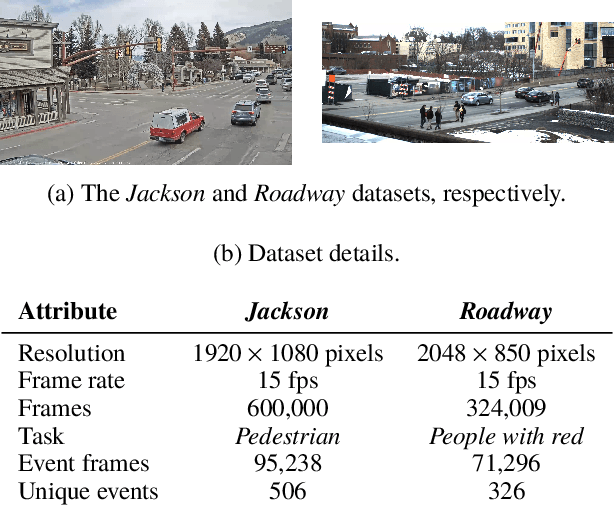

Abstract:As video camera deployments continue to grow, the need to process large volumes of real-time data strains wide area network infrastructure. When per-camera bandwidth is limited, it is infeasible for applications such as traffic monitoring and pedestrian tracking to offload high-quality video streams to a datacenter. This paper presents FilterForward, a new edge-to-cloud system that enables datacenter-based applications to process content from thousands of cameras by installing lightweight edge filters that backhaul only relevant video frames. FilterForward introduces fast and expressive per-application microclassifiers that share computation to simultaneously detect dozens of events on computationally constrained edge nodes. Only matching events are transmitted to the cloud. Evaluation on two real-world camera feed datasets shows that FilterForward reduces bandwidth use by an order of magnitude while improving computational efficiency and event detection accuracy for challenging video content.
3LC: Lightweight and Effective Traffic Compression for Distributed Machine Learning
Feb 21, 2018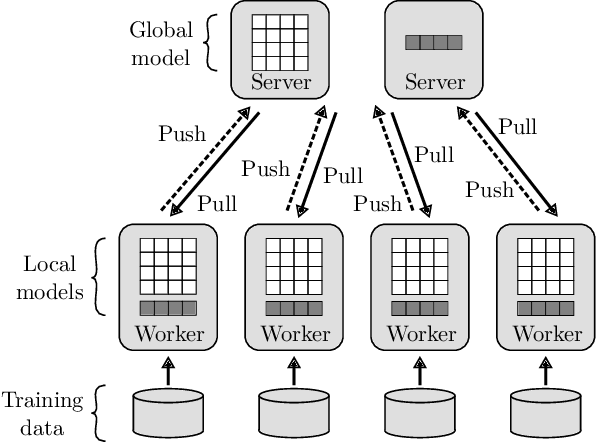
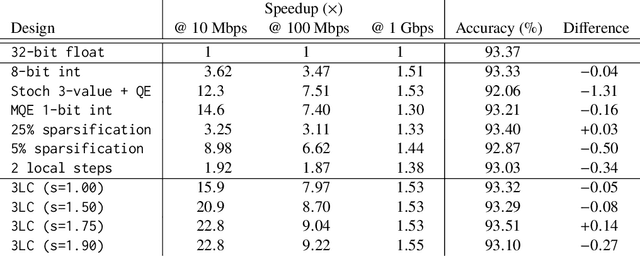
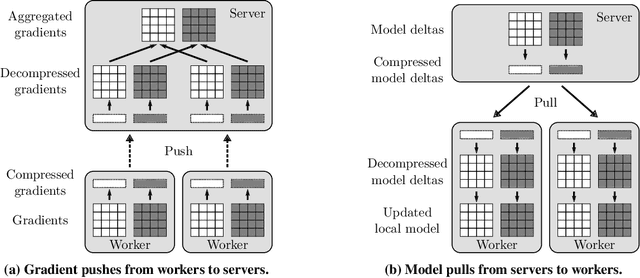
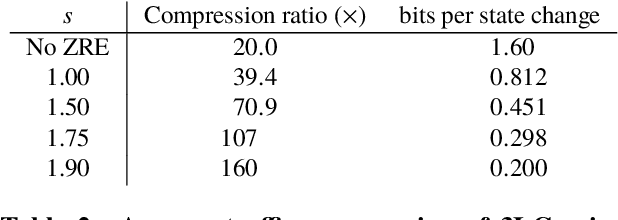
Abstract:The performance and efficiency of distributed machine learning (ML) depends significantly on how long it takes for nodes to exchange state changes. Overly-aggressive attempts to reduce communication often sacrifice final model accuracy and necessitate additional ML techniques to compensate for this loss, limiting their generality. Some attempts to reduce communication incur high computation overhead, which makes their performance benefits visible only over slow networks. We present 3LC, a lossy compression scheme for state change traffic that strikes balance between multiple goals: traffic reduction, accuracy, computation overhead, and generality. It combines three new techniques---3-value quantization with sparsity multiplication, quartic encoding, and zero-run encoding---to leverage strengths of quantization and sparsification techniques and avoid their drawbacks. It achieves a data compression ratio of up to 39--107X, almost the same test accuracy of trained models, and high compression speed. Distributed ML frameworks can employ 3LC without modifications to existing ML algorithms. Our experiments show that 3LC reduces wall-clock training time of ResNet-110--based image classifiers for CIFAR-10 on a 10-GPU cluster by up to 16--23X compared to TensorFlow's baseline design.
 Add to Chrome
Add to Chrome Add to Firefox
Add to Firefox Add to Edge
Add to Edge